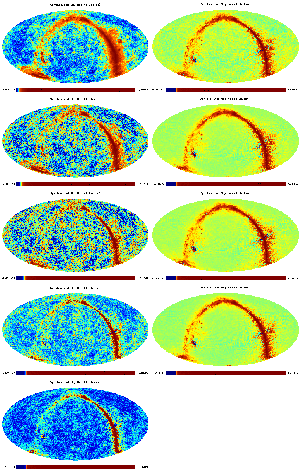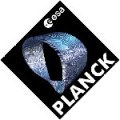 |
|
Simulated maps of the Cosmic Microwave Background at all
frequencies of the Planck satellite (30-1000 GHz)
|
|  |
Some of the most important questions in modern science include
- How did the Universe begin,
- how did it evolve to the state we observe today, and
- how will it continue to evolve in the future?
The  European
Space Agency's (ESA's) satellite mission Planck will help to
provide the answers. Planck's objective is to analyse, with the
highest accuracy ever achieved, the remnant radiation that filled the
Universe immediately after the Big Bang, which we observe today as the
Cosmic Microwave Background (CMB). Tiny variations in the temperature
of the CMB over the sky can be studied to provide accurate information
about the size, age, and geometry of the Universe. European
Space Agency's (ESA's) satellite mission Planck will help to
provide the answers. Planck's objective is to analyse, with the
highest accuracy ever achieved, the remnant radiation that filled the
Universe immediately after the Big Bang, which we observe today as the
Cosmic Microwave Background (CMB). Tiny variations in the temperature
of the CMB over the sky can be studied to provide accurate information
about the size, age, and geometry of the Universe.
The Planck mission, scheduled for launch in 2007,
will collect and characterise radiation from the CMB using sensitive
receivers operating at extremely low temperatures. The receivers are
able to measure temperature variations of a few millionths of a degree
around the average CMB temperature of roughly 2.7 Kelvin. These
measurements will be used to produce the best ever maps of variations
in the CMB radiation field, covering at least 95% of the sky over a
wide frequency range (~30 GHz - 1 THz). The simultaneous mapping of
the sky at a wide range of frequencies will enable the separation of
the primordial cosmological background signal from foreground
radiation due to both our own Galaxy and extragalactic sources. This
constitutes a vastly improved performance compared to balloon-borne
and ground-based experiments and will exceed the performance of other
space-based instruments.
The  MPA Planck Analysis Centre
(MPAC), as part of its responsibilities to the Planck project,
has produced a detailed end-to-end simulation package by integrating
various software modules provided by the Planck collaboration and the
CMB scientific community. These modules allow the generation of data
which mimic in great detail the observation strategy of the Planck
satellite and subsequent data processing to convert detector
measurements into sky maps for scientific analysis. This allows the
testing and optimisation of the data analysis software even before the
satellite's launch, and can provide an estimate of the accuracy of the
reconstructed CMB signal and extracted cosmological information given
the instrumental noise and astrophysical foreground contamination. MPA Planck Analysis Centre
(MPAC), as part of its responsibilities to the Planck project,
has produced a detailed end-to-end simulation package by integrating
various software modules provided by the Planck collaboration and the
CMB scientific community. These modules allow the generation of data
which mimic in great detail the observation strategy of the Planck
satellite and subsequent data processing to convert detector
measurements into sky maps for scientific analysis. This allows the
testing and optimisation of the data analysis software even before the
satellite's launch, and can provide an estimate of the accuracy of the
reconstructed CMB signal and extracted cosmological information given
the instrumental noise and astrophysical foreground contamination.
The available  web-based simulation tool
allows easy access to a simplified version of the Planck simulation
pipeline. Users are able to build realistic pictures of the CMB sky as
it will be observed by Planck, and study how the distribution of
temperature variations changes as the cosmological parameters are
modified. The web-service serves educational and scientific
applications. This project is a joint undertaking by web-based simulation tool
allows easy access to a simplified version of the Planck simulation
pipeline. Users are able to build realistic pictures of the CMB sky as
it will be observed by Planck, and study how the distribution of
temperature variations changes as the cosmological parameters are
modified. The web-service serves educational and scientific
applications. This project is a joint undertaking by  MPAC and the MPAC and the  German Astrophysical Virtual
Observatory (GAVO). German Astrophysical Virtual
Observatory (GAVO).



|





